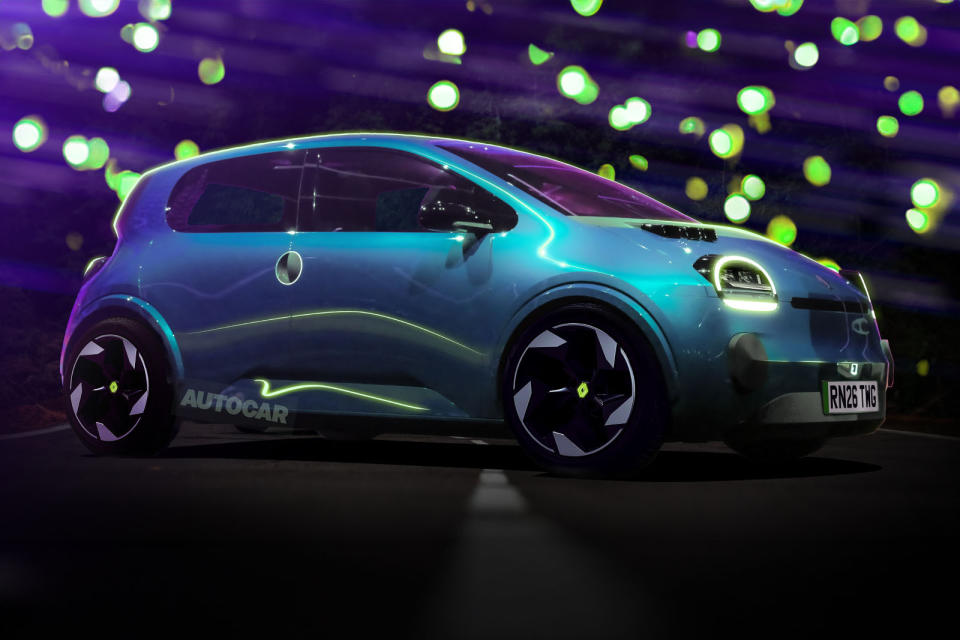2026 Renault Twingo: China deal boosts profit, cuts R&D spend

The retro supermini will be in showrooms in the first months of 2026 on current timings
Renault has partnered with a Chinese engineering firm to develop its sub-£17,000 Twingo city car after talks with Volkswagen about a potential collaboration proved fruitless.
The two firms had been evaluating the prospect of co-developing their respective entry-level city EVs. But Volkswagen will now work independently to bring its similarly conceived ‘ID 1’ to production in 2027.
Renault will instead be assisted by the unnamed Chinese manufacturing outfit, which is understood to be a supplier rather than a car maker.
“I wanted to show that European industry could work together as a team, so I think this is a lost opportunity,” Renault Group CEO Luca de Meo told Reuters after the talks ended, but work on the Twingo has continued.
The retro supermini is scheduled to be revealed in late 2025 and in showrooms in the first months of 2026 on current timings.
The concept freeze took place at the start of this year and Renault is committed to a 24-month development cycle.
De Meo has told Autocar that partnering with the unnamed Chinese firm is crucial to achieving this ambitious development timeframe and identifying efficiencies that the firm can employ to reduce costs.

Asked how Renault will make the Twingo profitable, he said: “We’ll do it by radically changing our production engineering and our component sourcing.
“Normally, we specify big components like HVAC systems from big tier-one suppliers. We send them a 1000-page holy book about how a Renault HVAC system should be, and they create a new one. But maybe these things are already there in our other cars. If they are, we’ll use them in future. We will be able to do a car on a cycle below 24 months.”
Slashing development lead times is important because it will allow Renault to be “more agile, more virtuous and more competitive”, de Meo has said previously. But another benefit of making the development and production process more efficient is that it could drastically reduce its cars’ environmental impact.
“We have research that proves that from cradle to grave, a new Twingo will have 75% less impact on the environment than an average European car now,” said de Meo. “If all of the cars in Paris were as small and economical as a Twingo, it would free up road space equivalent to the area of 60 football fields! And Paris is quite a small city…”
Accelerating the development of small electric cars like the Twingo is especially important in this context, suggested de Meo, because “authorities are going to close cities to cars with engines”.
Speaking separately to Autocar, product boss Bruno Vanel said collaborating with a Chinese firm means Renault has better oversight of “the technology that is coming, and we can better adapt the new technologies, take less risk and spend less in terms of development”.
Renault has yet to decide which plant will build the Twingo, but Vanel said the company’s ElectriCity industrial complex, centred in the north of France, gives “a footprint which is very concentrated” and allows it to build locally at competitive rates.

Vanel said: “We’ve got the batteries produced and assembled close to the plants. The electric motor is built not too far away [at Cléon]. The plant that produces the Scenic and Mégane will build Renault 5 – so all electric cars in quite big volumes, reducing the cost.”
As evidence of the viability of building small cars in Europe, Vanel pointed to the €25,000 (roughly £21,275) starting price of the 5. “This car is produced in France, and this car is profitable,” he said.
He even suggested that cheaper versions of the 5 could be added to the line-up if new battery technology allows – and they too would have a profit margin built in.
The question of localising EV production has become particularly poignant for Renault as the French government has begun offering substantial EV purchase incentives that favour European-built cars.
Subsidies of €5000-€7000 (£4255-£5955) are available on cars with a carbon footprint of below 14.75 tonnes, which inherently favours local production.

The hugely popular Dacia Spring, for example, is imported from China and the resulting increase in carbon footprint makes it ineligible for the grants.
This pushes its entry price from just over €17,000 (£14,465) to more than €22,000 (£18,720) in France.
Vanel acknowledged that it is “difficult” to compete at that price, emphasising the need to ensure the similarly sized Twingo is engineered, assembled and shipped as cost-effectively as possible.
]]>

 Yahoo Autos
Yahoo Autos 